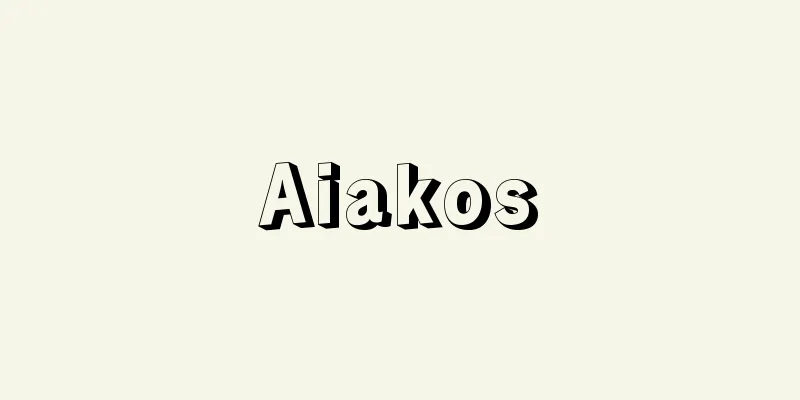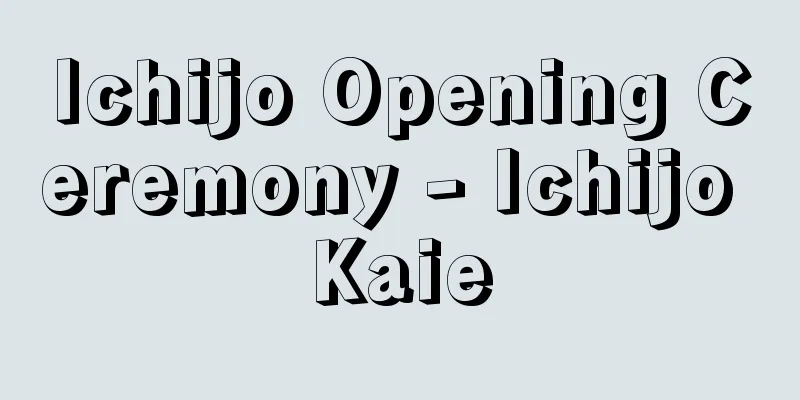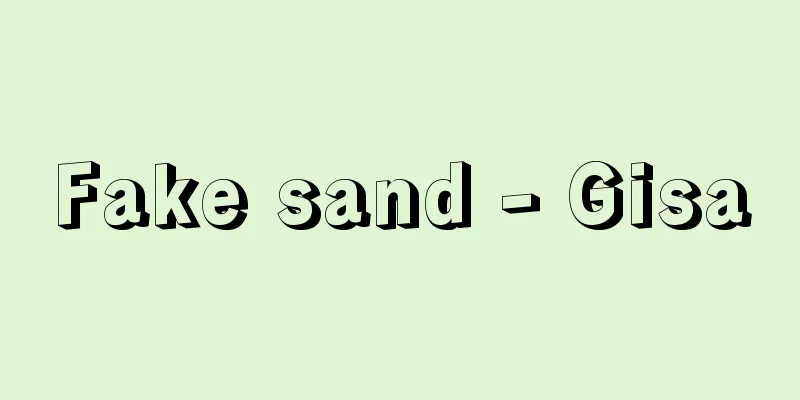Geza music

|
Accompaniment music for Kabuki, Yose, etc. Kabuki Geza MusicIn contrast to the entrance storytelling and introductory music used in dance performances, where performers line up on stage and perform in front of the audience, the performers do not appear to the audience, but perform hidden behind a black curtain in an area surrounded by black walls called "Shimoza" on the left side of the stage (as seen from the audience). Shimoza music is also shortened to "Shimoza" or "Kuromisu music". In principle, it is only performed by Nagauta performers. Unlike other types of music, Nagauta is mainly composed of songs and accompanied by music, making it suitable as an accompaniment to plays. Its origins are unclear, but it is said to have existed in the early days of Yaro Kabuki, and its current form was perfected during the time of Kawatake Mokuami at the end of the Edo period. The name originally referred to a corner at the back of the kamite (right) stage, called the "outer seat," which was the venue for performances in both Edo and Kamigata towards the end of the Kyoho era (1716-1736), and eventually became the name of the music performed there. As the stage machinery changed, in Edo it was moved to the back of the stage on the downstairs side around the Bunsei era (1818-1830) so that the performances on the hanamichi could be seen better, and by the Ansei era (1854-1860) it had moved to its current location, but in Kamigata it was performed on the kamite side until the Meiji era. Geza music can be used in a variety of ways, including "odoriji," which is performed as simple dance music that does not require an introductory tune, and "meriyasu," which is a solemn song sung mainly by an actor alone while he performs long gestures, but the most commonly used type is a type of music called "kage." The effects of kage can be broadly divided into three categories: to express scenery and atmosphere at the opening and closing of a performance or when changing scenes, to create emotion or express the character or psychology of an actor when he enters or exits the stage, and to highlight the lines and gestures of the actor during the performance. The instruments used in the performance are based on the shamisen and odaiko drum, and include the four rhythms of the flute, kototsuzumi, ototsuzumi, and taiko drums, as well as dozens of other instruments such as gakutaiko, obyoshi, kakko, hontsurigane, dora, soban, chappa, mokugyo, bangi, mokkin, kinuta, clappers, and yotsutake. There are many different ways of performing the shamisen, including singing only, shamisen only (aikata), and "utairi" (singing with singing), or the above instruments alone or in combination, or by adding singing and utaika. There are over 800 pieces currently in use, including singing, akata, and instruments. Of these, Edo (Tokyo) accounts for 60%. While there are certain conventions for both historical and domestic plays, the same play may use different music depending on the location, such as Edo or Kamigata, or on the actor, and this is one element that determines the style of the performance. In any case, when an actor moves or delivers lines in time with the music, the skill of that skill can make or break the role, and so it plays an extremely important role in Kabuki direction. The person who decides on the geza music to be played during a performance is called a "tsukeshi" and is usually a veteran music director. The book (usually a folded sheet of paper) that records the music is called a geza tsukecho, or geza tsuke for short. In addition, even in Shinpa dramas, geza music is used in classical plays, but in recent years the designation of this is called "sakucho" and the musicians in charge are sometimes called the sakuchobu (sakucho department). [Toshiaki Matsui] The backstage music of the vaudeville theaterIt is performed in the hayashi room below the stage, where a female expert plays the shamisen, and the opening rakugo performer plays drums, flutes, and bells. The Geza's duties are to provide accompaniment for the performers' entrance and exit, called "debayashi." In the past, there was no entrance accompaniment other than music or daikagura (a traditional Japanese dance performed with a dazzling chant) in Tokyo, but after the Rakugo Mutsumi Association was founded in 1917 (Taisho 6), exchanges between performers from the east and west began, and the customs of Osaka were introduced and entrance accompaniment began to be used in Tokyo as well. It is common for each performer to use a specific piece of music for the entrance accompaniment. The Geza also provide accompaniment for dance scenes, music, daikagura, magic tricks, spinning tops, and paper cutting, and there are an extremely large number of such pieces. In Osaka, the geza is especially important because most stories include music and the moments when the accompaniment is included are strictly regulated. The entrance accompaniment is also louder than in Tokyo, so that by listening to the accompaniment, it is possible to tell whether a futatsume or shin'uchi will be appearing. In recent years, the female shamisen players who play the geza (lower seat) have also come to be called "hayashi," but there have been complaints of a dearth of successors, and with the opening of the National Theater's entertainment hall in 1979 (Showa 54), the theater has begun training yose hayashi performers. [Toshiaki Matsui] Source: Shogakukan Encyclopedia Nipponica About Encyclopedia Nipponica Information | Legend |
|
歌舞伎(かぶき)、寄席(よせ)などの伴奏音楽。 歌舞伎の下座音楽舞踊などで演奏者が舞台に居並び観客の面前で演奏する出語りや出囃子(でばやし)に対するもので、演奏者は観客に姿を見せず、舞台下手(しもて)(客席から見て左)の「下座」とよばれる、黒塀で囲まれた場所の黒い御簾(みす)がかかった内側に隠れて演奏する。下座音楽のことを略して単に「下座」ともいい、黒御簾(くろみす)音楽ともよぶ。担当するのは原則として長唄(ながうた)連中に限られる。ほかの音楽と違って、長唄は謡物を主とし、囃子が付属しているため、劇の伴奏には好適だからといわれる。 起源は明らかでないが、野郎(やろう)歌舞伎の初期には存在していたといわれ、幕末の河竹黙阿弥(もくあみ)の時代に現在の形が完成した。名称については、本来舞台上手(かみて)(右)奥の一角を「外座(げざ)」と称し、享保(きょうほう)(1716~36)末期には江戸でも上方(かみがた)でもそこが演奏の場所だったのが、やがて演奏される音楽の名にもなったもの。舞台機構の変化に伴い、花道での演技がよく見えるように、江戸では文政(ぶんせい)(1818~30)ころから下手奥に移され、安政(あんせい)(1854~60)ころには現在の場所になったが、上方では明治期まで上手で演奏されていた。 下座音楽の使い方には、出囃子の必要に及ばない簡単な舞踊の地音楽として演奏される「踊り地」、俳優が長いしぐさを演じるときにしんみりした唄をおもに独吟で歌う「めりやす」などもあるが、もっとも多く使われるのは「陰(かげ)」とよばれる演奏である。陰の効用は大別して、開幕・閉幕・場面転換などのときに情景や雰囲気を表すもの、俳優の登場・退場のときに情緒を醸し出したり、その性格や心理を表すもの、演技中に台詞(せりふ)やしぐさを引き立てるものの三つに分けられる。演奏に使う楽器としては、三味線と大太鼓を基本として、四拍子とよばれる笛、小鼓、大鼓、太鼓のほか、楽(がく)太鼓、大拍子、羯鼓(かっこ)、本釣鐘(ほんつりがね)、銅羅(どら)、双盤(そうばん)、チャッパ、木魚(もくぎょ)、盤木(ばんぎ)、木琴(もっきん)、砧(きぬた)、拍子木、四つ竹など数十種があげられる。演奏の方法としては、唄だけの場合、三味線だけの場合(合方(あいかた))、これに唄が加わる「唄入り」の場合、あるいは前記の鳴物類が単独または組合せの場合、さらに唄・合方が加えられることなどにより、さまざまな種類がつくられる。現在使われる曲は、唄、合方、鳴物を含め800曲以上。そのうち江戸(東京)が6割を占める。時代物と世話物、それぞれ作品・場面によっていちおうの約束ができているが、同じ演目でも江戸と上方、あるいは俳優によって、異なる曲を使うこともあり、それが演出の型を構成する一要素になっている。いずれにしても、俳優が音楽にのって動いたり、台詞をいったりするとき、その巧拙によって役を生かしも殺しもするわけで、歌舞伎の演出にはきわめてたいせつな役目を果たす。 上演に際して下座音楽の指定を考える人を「付師(つけし)」といい、音楽担当者のベテランがこれにあたる。その指定を記した帳面(普通、半紙二つ折り)を下座付帳、略して下座付という。 なお、新派劇でも古典的な演目では下座音楽を使うが、近年はこれを指定することを「作調(さくちょう)」と称し、担当の演奏家たちが作調部とよばれることもある。 [松井俊諭] 寄席の下座音楽高座下手の囃子部屋で演奏されるもので、女性の専門家が三味線を弾き、前座の落語家が太鼓、笛、鐘などで合奏する。下座のつとめは、まず芸人の登場・退場のときの囃子で、これを「出囃子」という。東京では昔は音曲か太神楽(だいかぐら)以外は出囃子はなかったが、1917年(大正6)落語睦(むつみ)会創立後、東西の芸人の交流が始まり、大阪の習慣が移入されて東京でも出囃子を使うようになった。出囃子は芸人によってそれぞれ決まった曲を使うのが普通である。下座はほかに、踊りの地、音曲の伴奏、太神楽・奇術・曲独楽(きょくごま)・紙切りなどの囃子をするが、その曲はきわめて多い。 大阪では、大部分の噺(はなし)が音曲入りで、囃子の入る場面も厳密に決まっているため、下座はとくに重要である。出囃子も東京以上にやかましく、囃子を聞けば、二つ目が出るのか、真打が出るのかわかるようになっている。 下座を担当する女性三味線弾きも近年は「囃子」とよばれるようになったが、しだいに後継者難が叫ばれるようになり、国立劇場では1979年(昭和54)の演芸場発足に伴い、寄席囃子の技芸者養成を実施している。 [松井俊諭] 出典 小学館 日本大百科全書(ニッポニカ)日本大百科全書(ニッポニカ)について 情報 | 凡例 |
>>: The Record of Plays - Kezairoku
Recommend
Ojoyoshu - Collection of the Essentials for Rebirth
This Buddhist book was written in the mid-Heian p...
Affines
…Kinship ties are linked across generations throu...
God's horse - Kamikoma
A horse dedicated to a shrine, meaning a horse rid...
Asamiya
The name of Shigaraki Town, Koka City, southern S...
Grawitz's tumor
...This is a malignant tumor that develops in the...
The Tripitaka of Goryeo - The Tripitaka of Goryeo
The Tripitaka engraved and printed in Goryeo. The ...
Kaga [city] - Kaga
A city in the southwestern tip of Ishikawa Prefect...
Wrinkle method - Shunpo
A painting technique used in oriental painting to...
Indonesian - Indonesiago
It is a language of the Hesperonesian branch of t...
Cut rice - Kirimai
〘 noun 〙① In the Middle Ages, the contract to pay ...
Gracian (English spelling) Baltasar Gracián y Morales
1601‐58 Spanish writer and Jesuit. He served as pr...
Rhacophorus reinwardti (English spelling) Rhacophorusreinwardti
… [Takahiro Matsui]. … *Some of the terminology t...
rotary snow-plow
...railroad vehicles used for clearing snow from ...
Fire salamander
... Among newts, the genus Tylototriton , found i...
Ame no Hiboko no Mikoto - Ame no Hiboko no Mikoto
...It is located in Izushi-cho, Izushi-gun, Hyogo...









